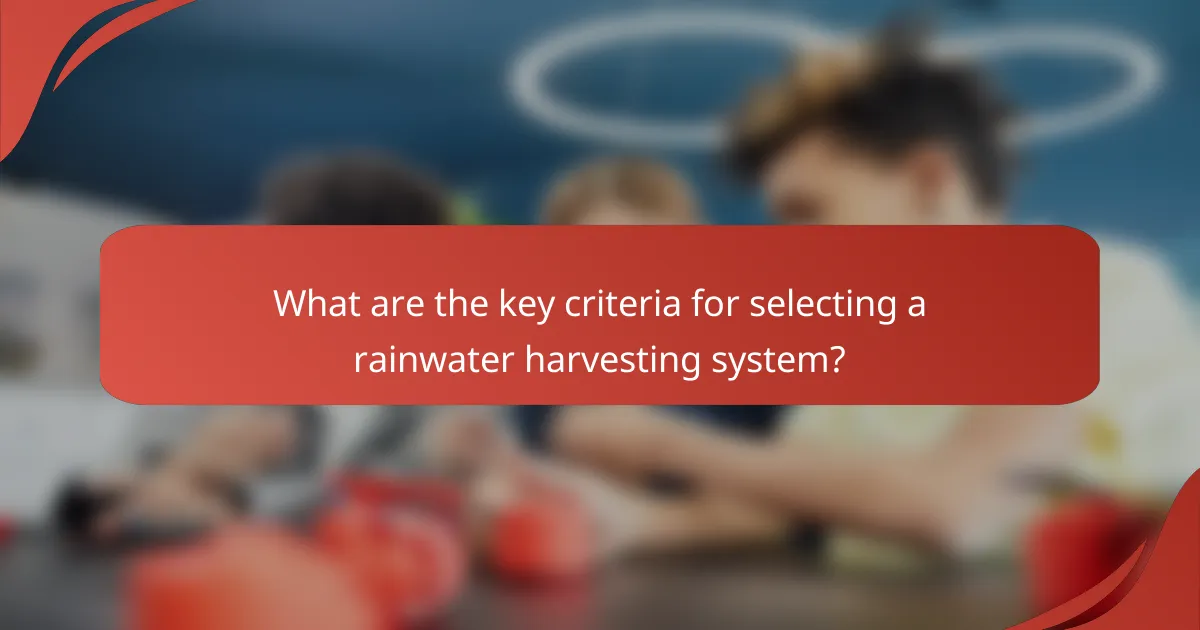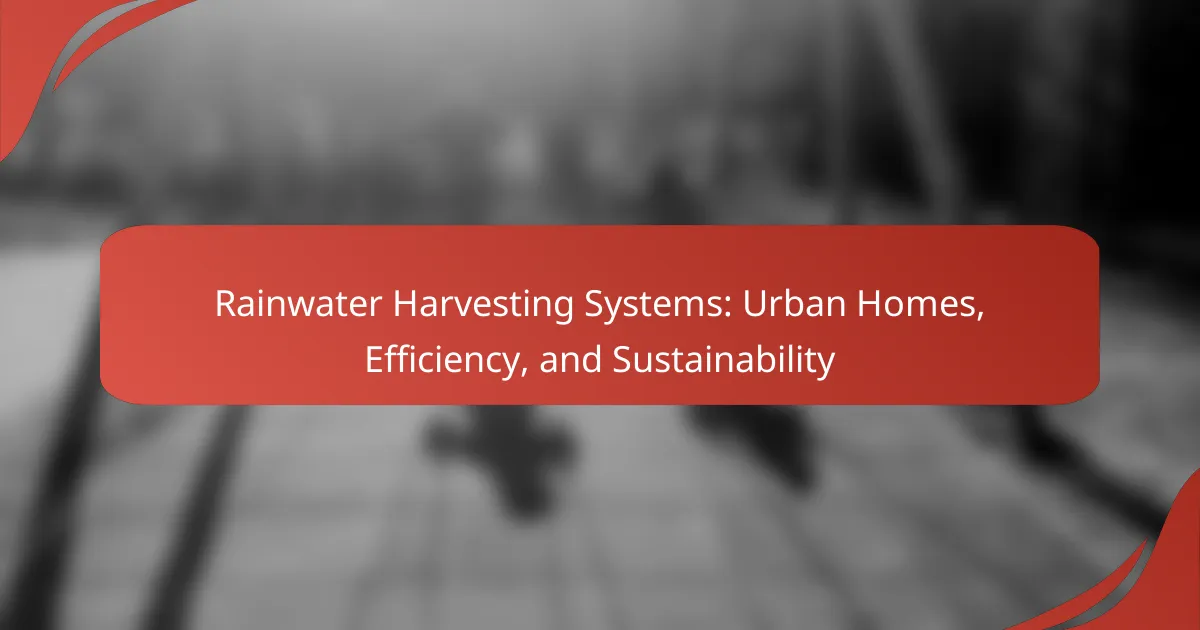Rainwater harvesting systems in urban homes provide an efficient solution for collecting and storing rainwater for irrigation and non-potable uses. By utilizing a network of gutters, downspouts, and storage tanks, these systems help reduce water bills and reliance on municipal supplies, while also promoting sustainability and resilience against climate change impacts.

How do rainwater harvesting systems work in urban homes?
Rainwater harvesting systems in urban homes collect and store rainwater for various uses, such as irrigation and non-potable household needs. These systems typically consist of a network of gutters, downspouts, and storage tanks that efficiently capture and manage rainwater runoff.
Components of rainwater harvesting systems
The main components of a rainwater harvesting system include catchment surfaces, gutters, downspouts, storage tanks, and filtration systems. Catchment surfaces, often rooftops, collect rainwater, which flows through gutters and downspouts into storage tanks. Filtration systems ensure that the collected water is clean and suitable for its intended use.
Storage tanks can vary in size, ranging from small barrels for individual homes to large cisterns for community systems. It’s essential to choose materials that are durable and resistant to corrosion, such as polyethylene or fiberglass, to ensure longevity.
Process of collecting and storing rainwater
The process begins with rain falling on the catchment surface, where it is directed into gutters and downspouts. From there, the water flows into the storage tank, often equipped with a first-flush diverter that discards the initial runoff, which may contain debris and contaminants.
Once in the tank, the water can be stored for later use. Regular maintenance, such as cleaning gutters and inspecting tanks, is crucial to prevent blockages and ensure the system operates efficiently.
Benefits for urban households
Rainwater harvesting systems offer several benefits for urban households, including reduced water bills and decreased reliance on municipal water supplies. By utilizing harvested rainwater, homeowners can save on costs, especially in areas with high water rates.
Additionally, these systems contribute to sustainability by reducing stormwater runoff, which can help prevent flooding and erosion in urban environments. Implementing a rainwater harvesting system can also enhance a home’s resilience to water shortages during dry periods.

What are the efficiency benefits of rainwater harvesting?
Rainwater harvesting systems offer significant efficiency benefits by capturing and utilizing rainwater for various household needs, leading to cost savings and environmental advantages. These systems can reduce water bills, decrease reliance on municipal water supplies, and improve the overall quality of water used in urban homes.
Reduction in water bills
Implementing a rainwater harvesting system can lead to substantial reductions in monthly water bills. By using harvested rainwater for irrigation, toilet flushing, and laundry, homeowners can significantly decrease their dependence on treated municipal water, which often comes at a higher cost.
For example, in regions with moderate rainfall, households may save anywhere from 30% to 50% on their water expenses. This not only helps in budgeting but also encourages more sustainable water usage practices.
Decreased reliance on municipal water supply
Rainwater harvesting systems lessen the burden on municipal water supplies, especially during peak demand periods. By utilizing rainwater, households contribute to more sustainable water management, reducing the strain on local infrastructure and resources.
In urban areas, where water scarcity can be a concern, this practice can help maintain a balanced water supply. Homeowners should consider local regulations regarding rainwater use, as some municipalities may have specific guidelines or incentives for implementing such systems.
Improved water quality
Rainwater is often cleaner than municipal water, as it is free from many of the chemicals used in water treatment processes. When properly collected and filtered, rainwater can be used for various non-potable applications without the need for extensive treatment.
However, it is essential to maintain the collection system and ensure that the storage tanks are clean to prevent contamination. Regular maintenance and monitoring can help ensure that the harvested rainwater remains a high-quality resource for household use.

What are the sustainability impacts of rainwater harvesting?
Rainwater harvesting significantly enhances sustainability by reducing reliance on municipal water supplies and minimizing stormwater runoff. This practice not only conserves water but also supports urban resilience against climate change impacts.
Conservation of natural resources
Rainwater harvesting systems capture and store rainwater for various uses, reducing the demand for treated drinking water. By utilizing rainwater, urban homes can decrease their water bills and lessen the strain on local water sources, especially during dry periods.
Implementing a rainwater harvesting system can lead to significant water savings, often capturing thousands of liters annually, depending on the roof size and rainfall patterns. Homeowners should consider installing systems that can hold at least a few hundred liters to maximize efficiency.
Mitigation of urban flooding
By collecting rainwater, these systems help reduce the volume of stormwater that enters drainage systems, which can prevent urban flooding. This is particularly beneficial in cities where heavy rainfall can overwhelm existing infrastructure.
Homeowners can install permeable surfaces and rain gardens alongside their harvesting systems to further manage runoff. These practices can significantly lower the risk of localized flooding during heavy rain events.
Support for local ecosystems
Rainwater harvesting contributes to the health of local ecosystems by maintaining groundwater levels and reducing surface runoff that can carry pollutants. This practice helps sustain nearby flora and fauna, promoting biodiversity in urban areas.
Using harvested rainwater for irrigation supports gardens and green spaces, which can attract beneficial insects and wildlife. Homeowners should consider integrating native plants into their landscaping to enhance ecological benefits while utilizing harvested water effectively.

What are the key criteria for selecting a rainwater harvesting system?
When selecting a rainwater harvesting system, consider factors such as system size, filtration options, and installation requirements. These criteria will help ensure the system meets your household’s needs and complies with local regulations.
System size and capacity
The size and capacity of a rainwater harvesting system should align with your household’s water usage and the local rainfall patterns. For urban homes, a system that captures between 1,000 to 5,000 liters is common, depending on roof area and average precipitation.
Evaluate your water needs by assessing daily consumption and seasonal variations. A larger tank may be beneficial in areas with less frequent rainfall, while smaller systems can suffice in regions with consistent rain.
Filtration and treatment options
Effective filtration and treatment are crucial for ensuring harvested rainwater is safe for use. Basic systems often include first-flush diverters and mesh screens to remove debris, while more advanced options may involve sediment filters and UV treatment.
Consider the intended use of the harvested water. For irrigation, simpler filtration may be adequate, but for indoor use, more comprehensive treatment systems are recommended to meet health standards.
Installation requirements
Installation requirements for rainwater harvesting systems vary based on local regulations and the complexity of the system. Basic systems can often be installed by homeowners, while larger systems may require professional installation to ensure compliance with safety standards.
Check local building codes and regulations regarding rainwater harvesting, as some areas may have specific guidelines on tank placement, plumbing connections, and permits. Proper installation is essential to maximize efficiency and prevent contamination.

What are the costs associated with rainwater harvesting systems?
The costs of rainwater harvesting systems can vary significantly based on factors such as system size, installation complexity, and local regulations. Generally, homeowners should consider both initial installation costs and ongoing maintenance expenses to fully understand the financial commitment involved.
Initial installation costs
Initial installation costs for rainwater harvesting systems typically range from a few hundred to several thousand dollars, depending on the system’s capacity and complexity. Basic systems, which may include a simple barrel setup, can be relatively inexpensive, while more advanced systems with filtration and storage tanks can be much pricier.
Homeowners should also factor in potential costs for permits or inspections, which can vary by region. It’s advisable to obtain multiple quotes from local contractors to ensure a competitive price and to understand what is included in the installation package.
Maintenance and operational expenses
Maintenance and operational expenses for rainwater harvesting systems are generally low but should not be overlooked. Regular tasks may include cleaning filters, inspecting tanks, and ensuring the system is functioning properly. These activities can typically be performed by the homeowner or a professional, depending on the system’s complexity.
Annual maintenance costs can range from a few dozen to a few hundred dollars, depending on the system’s size and any required professional services. Keeping up with maintenance can help prevent costly repairs and ensure the system operates efficiently.
Potential savings over time
Over time, rainwater harvesting systems can lead to significant savings on water bills, especially in areas with high municipal water rates. By utilizing harvested rainwater for irrigation, toilet flushing, and other non-potable uses, homeowners can reduce their reliance on the municipal water supply.
In some regions, homeowners may also benefit from tax incentives or rebates for installing rainwater harvesting systems, which can further offset initial costs. Evaluating local regulations and available financial incentives can help maximize the long-term savings associated with these systems.

What are the best practices for maintaining rainwater harvesting systems?
Maintaining rainwater harvesting systems involves regular inspections, cleaning, and monitoring to ensure optimal performance and longevity. Following best practices can enhance efficiency and sustainability while preventing contamination and system failures.
Regular inspection and cleaning
Regular inspections are crucial for identifying potential issues in rainwater harvesting systems. Check components such as gutters, downspouts, and storage tanks for debris, leaks, or blockages at least twice a year, ideally before and after the rainy season.
Cleaning is equally important; remove leaves and sediment from gutters and filters to maintain water quality. A simple checklist can include tasks like rinsing out storage tanks, checking for algae growth, and ensuring that all connections are secure.
Consider using a professional service for thorough inspections if your system is complex or if you notice persistent issues. This proactive approach can save costs associated with major repairs or system replacements in the long run.
